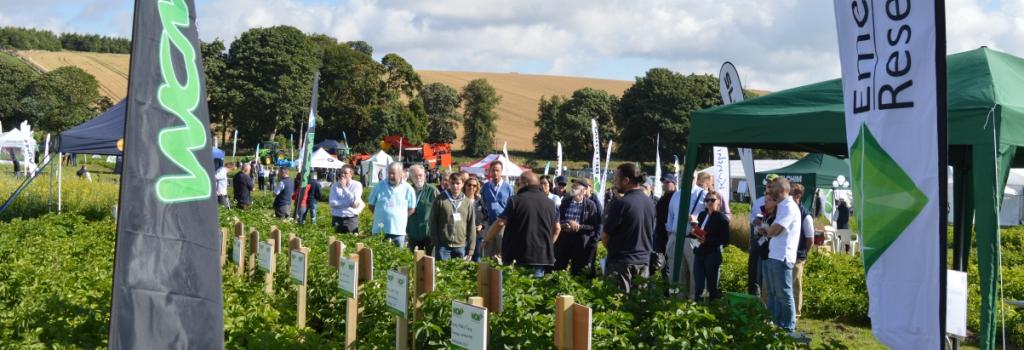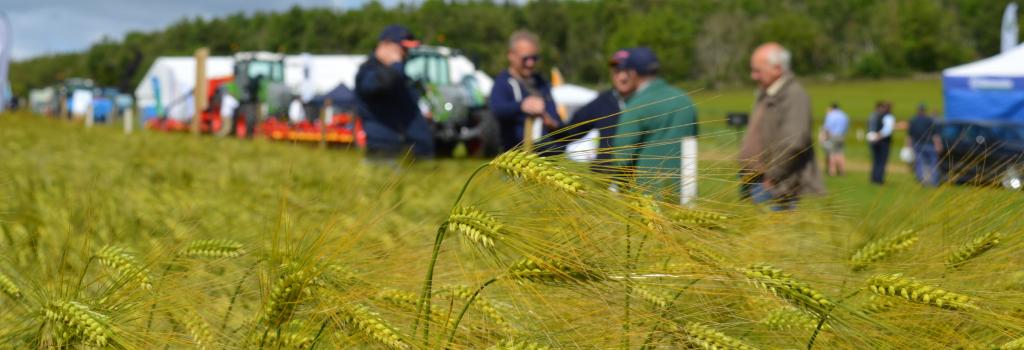Dr Craig G Simpson, James Hutton Institute
Presentation to the Scottish Society of Crop Research, 25th May 2022.

Getting gene-edited crops out of the glasshouse. To demonstrate the full value of these crops in the growing environment requires controlled field evaluations.
Generating new high-yielding, safe, nutritious, climate-resilient crops is essential to alleviate the many well-documented pressures on agriculture1. Gene-editing (GE) or precision breeding is a remarkable new tool that is fundamentally different from established conventional breeding and GM methods. Conventional breeding mixes genes2 from related species without the need for prior knowledge of the underlying genes involved. It often leaves background genetic material from the donor plant that we know nothing about, and we select for the trait. GM plants are produced by isolating a gene from a related cultivar, landrace or wild type (cisgenesis) or by isolating a gene from an unrelated species (transgenesis) and inserting it into the selected elite crop. The result of this procedure is to increase the number of genes in the crop by one gene (or more if other genes are added). GM, therefore, provides the opportunity to develop novel crops. Gene-editing, as the name suggests, edits the target gene directly and precisely within the genome of an elite with no additional genetic material and no increase in gene number. GE is usually used to induce a gene mutation that knocks out the function of the targeted gene with the associated crop benefit3. The method is more precise than conventional breeding and GM procedures and is comparatively easy to implement with a saving in time and cost to establish the new crop.
GE was designed by repurposing a system discovered in bacteria as a defence against bacterial viruses in the laboratories of Profs Jennifer Doudna and Emmanuel Charpentier4. GE was found to work in more complex organisms, leading to its use in plants5. CRISPR-Cas9 (Clustered Regularly Interspaced Short Palindromic Repeats – CRISPR associated protein 9), is one of several GE versions that allow targeted mutational change in plant genes. Cas9 is the nuclease (DNA cutter) that is guided to its target by the guide RNA (gRNA)6. DNA is double-stranded and both strands are cut by Cas9 and the plant uses its DNA repair processes to repair the cut, causing the mutational change and knockout of gene function7. In plants, there can be an intermediary step that creates a transgenic plant to contain the CRISPR-Cas9 components to allow the mutation to occur, but this is removed completely to produce a transgene-free plant with the mutational change and the crop benefit. Protocols use methods like PCR to confirm its removal. There are also developing methods that remove this intermediary step altogether by using transitory delivery of the assembled Cas9 protein-gRNA into the cell to generate the mutation.
The advantages of GE to agriculture are potentially huge and will benefit many of us. Genes can be targeted to increase the farmer's yield, and reduce spraying of fertilisers, herbicides, fungicides, and insecticides to reduce tractor time and tilling with the benefit of reduction in carbon emissions. Crops may be rapidly adapted to changing environments or climates and/or develop resistance to newly emerging diseases. Food processors and consumers may benefit from extended shelf life and improvement in storage. Consumers may further benefit from food that is easier to eat by removing seeds and pits from our fruits8. We have spent thousands of years breeding our crops to reduce the many toxins and allergens that plants produce as part of their natural defence against animals (and people). We have learned to manage these risks with the obvious benefit of eating more safely. GE can reduce these health risks further to improve our food crop species. An example is the knocking out of multiple gliadin genes, a component of gluten to produce low gluten wheat9. Biofortification and improved nutrition of our foods is a further opportunity made possible by GE. In Japan, a tomato with increased GABA content is available to buy from markets from September 202110. GABA is used in Japan as a de-stressor to lower blood pressure and produce a calming effect. With no addition of genetic material, the plant was not considered a GMO, but the company interacted with the regulatory agencies, distributed fruits were labelled and information to take consumers to a website to explain the product. More recently in the UK, tomatoes fortified with vitamin D have been developed11. With many gene targets to choose from, GE offers many great opportunities and benefits to agriculture and food production.
The lower costs, simpler technology, and broader range of potential gene-edited products mean this technology has a great opportunity and potential to be used by low to middle-income countries and develop crops that are less targeted to company profit. With expected improvements in yields, reduced crop protection products, less requirement to develop new areas of land and the conservation of biodiverse environments it can help provide a range of public good benefits. However, it is recognised that acceptance in society will require more social dialogue, transparency and openness by researchers, public institutions and industry using the technology to bring what looks like clear environmental, food and nutritional benefits to everyone.
GE is not a cure-all. It is one more tool in the toolbox. We will, likely, always use a mix of conventional, GM and GE strategies to develop new crop varieties to get the best sustainable outcomes. Where GE will be particularly useful is crops with complex and multiple copy genomes12, crops you cannot breed quickly (eg. fruit trees), and where multiple gene copies are involved in biochemical pathways leading to traits. It will not replace the value good farming practice and agronomy brings. Like ALL methods of producing new crop cultivars, extensive objective field evaluations will establish enhanced crops to deliver to farmers and national lists. The recent simpler requirements legislated in England will help get GE cultivars out of the glasshouse into the field to allow for complete field evaluations13. The other home nations, including Scotland, continue to follow EU guidance for now. We are at a time where we need to use all our skills and technologies to solve agricultural problems and crop improvement. GE is a powerful and necessary addition to our toolbox to accelerate plant breeding. But it will require full field testing to demonstrate the benefits we anticipate and ensure there are no unintended consequences.
Dr Craig Simpson has worked as a plant molecular biologist for over 30 years. He started at the Plant Breeding Institute in Cambridge and came to the University of Dundee to work in the area of plant gene expression where he completed his PhD. He continues to work in this area at the James Hutton Institute, working with new sequencing methods to study the expression of genes in crop species under different environmental stresses.
References, discussion points and further information:
1. Pressures on Agriculture. The world population is approaching 8 billion, the population has increased by over 200 million in the last 4 years despite the covid pandemic. Many yield values for our crops are plateauing. Farmers are under pressure to reduce inputs – fertilisers, herbicides, insecticides. In 2020, 928 million people are food insecure, and 3 billion people cannot afford a nutritious meal. We lose/waste about a third of our food. Agriculture needs to adapt to a changing climate. How can the decline in global biodiversity be reduced given the need to supply food? Agricultural land is reducing due to salt and water pressures. The recent war in Ukraine has highlighted the limitations of our food supply and chain. Conventional crop technology alone will not feed the immense increase in population expected. We need higher-yielding, more efficient, climate-adapted crop varieties. There is a need to use all the crop development tools available to us.
2. What is a gene? The construction plan for forming and maintaining an organism is ‘memorised’ as a specific sequence of DNA modules called genes. DNA is a chemical code. The code is arranged along the length of the DNA strand and is unique to all individuals - except identical twins when they are born or when plants are clonally propagated. Many plants are clonally propagated to retain the same genetic DNA code. The DNA code is a unique order of 4 different bases that we describe simply as four letters A, C, G and T. Because A always pairs with T and G pairs with C we have a copying system and that is the basis for DNA copying or replication. DNA replication is the basis of genetics and how traits are passed on. Think of DNA as the hard disc of your computer. Genes are the programs found on the hard disc. ~30,000 genes give the construction plan for forming and maintaining a plant. The plan is realised through gene expression and how traits show themselves. Like the programs on a computer hard disc, genes are activated and switched on in a process called gene expression. RNA carries the genetic message from DNA to the cell's protein-making machines and it is the action of these expressed genes that give us our traits. For fun puzzles with DNA sequences: https://ics.hutton.ac.uk/pp21/#/dna
3. GE is usually used to generate a mutational knockout of the gene. It can also, with the help of donor DNA, be used for replacing parts of genes or for gene insertion. This is less efficient and there are other methods to do this.
4. Martin Jinek, M., Chylinski, K., Fonfara, I. et al. A Programmable Dual-RNA–Guided DNA Endonuclease in Adaptive Bacterial Immunity. Science 337, 816-821 (2012). https://doi.org/10.1126/science.1225829
5. Feng, Z., Zhang, B., Ding, W. et al. Efficient genome editing in plants using a CRISPR/Cas system. Cell Res 23, 1229–1232 (2013). https://doi.org/10.1038/cr.2013.114
6. Guide RNAs (gRNAs) consist of ~20 nucleotides of sequence that matches the target gene sequence, it further contains a scaffold sequence that is recognised and bound by the cas9 protein. An additional, very short protospacer adjacent motif (PAM) in the target genomic DNA is required for the gRNA/Cas9 complex to bind to the target sequence. It is relatively easy to design and make the sequence matching the target, within important limiting factors (eg. GC content, sequence length, mismatches, PAM, Cas nuclease used). The gRNA combines with the Cas9 to form a complex of both the RNA and the protein. The nuclease cuts 3-4 nucleotides upstream of the PAM sequence.
7. Gene editing video. https://www.youtube.com/watch?v=2pp17E4E-O8
8. https://www.bbc.co.uk/news/business-57332484 How farmers and scientists are engineering your food By Emma Woollacott BBC Technology of Business reporter, 22 June 2021. Also https://www.pairwise.com/conscious-foods
9. Susana Sánchez-León, S., Gil-Humanes, J., Ozuna, C.V., et al. Low-gluten, nontransgenic wheat engineered with CRISPR/Cas9. Plant Biotechnology Journal (2018) 16, 902–910 https://doi.org/10.1111/pbi.12837
10. https://sanatech-seed.com/en/20201211-2-2/ and https://sanatech-seed.com/en/product-trait-en/
11. Li, J., Scarano, A., Gonzalez, N.M. et al. Biofortified tomatoes provide a new route to vitamin D sufficiency. Nat. Plants (2022). https://doi.org/10.1038/s41477-022-01154-6
12. A genome is the complete DNA/genetic content of a cell; it contains a complete set of genes.2 Some plants have multiple copies of genomes. For example, many of our potato crops are tetraploid (4 copies of the genome). Wheat is hexaploid (6 copies of the genome). We humans are diploid (2 copies of the genome).
13. The Genetically Modified Organisms (Deliberate Release) (Amendment) (England) Regulations 2022 (legislation.gov.uk) and https://www.bbc.co.uk/news/science-environment-61563299.


